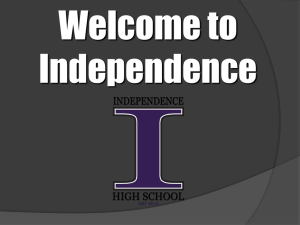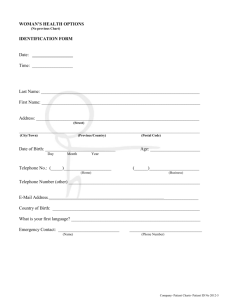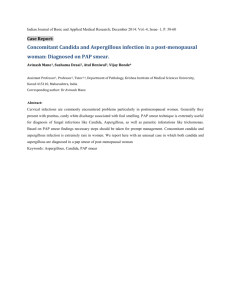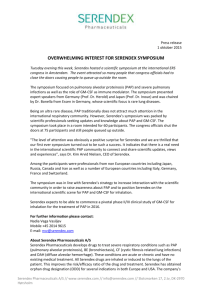QUIZ PC2 Part I
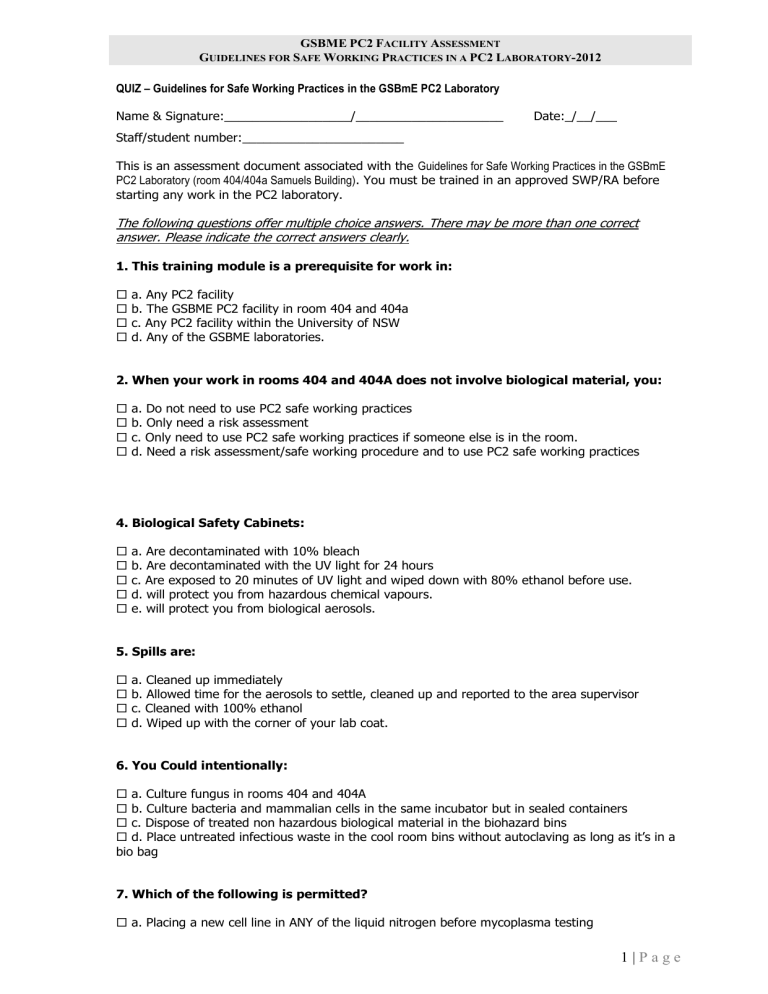
GSBME PC2 F ACILITY A SSESSMENT
G UIDELINES FOR S AFE W ORKING P RACTICES IN A PC2 L ABORATORY -2012
QUIZ – Guidelines for Safe Working Practices in the GSBmE PC2 Laboratory
Name & Signature:__________________/_____________________ Date:_/__/___
Staff/student number:_______________________
This is an assessment document associated with the Guidelines for Safe Working Practices in the GSBmE
PC2 Laboratory (room 404/404a Samuels Building) . You must be trained in an approved SWP/RA before starting any work in the PC2 laboratory.
The following questions offer multiple choice answers. There may be more than one correct answer. Please indicate the correct answers clearly.
1. This training module is a prerequisite for work in:
a. Any PC2 facility
b. The GSBME PC2 facility in room 404 and 404a
c. Any PC2 facility within the University of NSW
d. Any of the GSBME laboratories.
2. When your work in rooms 404 and 404A does not involve biological material, you:
a. Do not need to use PC2 safe working practices
b. Only need a risk assessment
c. Only need to use PC2 safe working practices if someone else is in the room.
d. Need a risk assessment/safe working procedure and to use PC2 safe working practices
4. Biological Safety Cabinets:
a. Are decontaminated with 10% bleach
b. Are decontaminated with the UV light for 24 hours
c. Are exposed to 20 minutes of UV light and wiped down with 80% ethanol before use.
d. will protect you from hazardous chemical vapours.
e. will protect you from biological aerosols.
5. Spills are:
a. Cleaned up immediately
b. Allowed time for the aerosols to settle, cleaned up and reported to the area supervisor
c. Cleaned with 100% ethanol
d. Wiped up with the corner of your lab coat.
6. You Could intentionally:
a. Culture fungus in rooms 404 and 404A
b. Culture bacteria and mammalian cells in the same incubator but in sealed containers
c. Dispose of treated non hazardous biological material in the biohazard bins
d. Place untreated infectious waste in the cool room bins without autoclaving as long as it’s in a bio bag
7. Which of the following is permitted?
a. Placing a new cell line in ANY of the liquid nitrogen before mycoplasma testing
1 | P a g e
GSBME PC2 F ACILITY A SSESSMENT
G UIDELINES FOR S AFE W ORKING P RACTICES IN A PC2 L ABORATORY -2012
b. Using large amounts of bleach (sodium hypochlorite) to treat materials that will be autoclaved.
c. Using the biohazard cabinet to protect you from dangerous chemical fumes
d. Creating a non-genetically-modified cell line from a primary source
8. Which of the following is correct?
a. Ethanol is a flammable liquid
b. Bleach can be used in ALL circumstances as a disinfectant as it’s the best
c. Pipette tips can go in the liquid waste containers because they are only small.
d. Human blood waste must be autoclaved before disposal in the biowaste bins
9. Which of the following is correct?
a. All work relating to Genetically Modified Organisms (GMOs) must be approved by the UNSW
Institutional Biosafety Committee and conducted in a registered OGTR lab.
b. You may use Genetically Modified Organisms in the GSBME PC2 lab
c. The GSBME PC2 labs are registered for GMO use
d. You can use GMO’s in the GSBME PC2 labs if they come from within UNSW
10. When working in the GSBME PC2 area, you:
a. Only report near miss accidents to the laboratory manager if something gets broken.
b. Need training if you want to use scalpel blades and/or needles
c. Do not need to label the non hazardous culture media
d. Must have an approved risk assessment for your work
11. When you wish to use a GMO in the PC2 lab, you:
a. Must be pretty sure it’s an exempt dealing because you got it from another UNSW lab
b. Must get an exempt dealing certificate from the Internal Biosafety Committee (IBC)
c. Must put a red GMO label on the container and placed in their own incubator
d. Realise that the GSBME labs are not an OGTR facility and you will need to do your work elsewhere, if you can’t get and exempt dealing approval.
12. All PC2 solid biological waste must be:
a. Labelled, tied up and placed in the yellow bin in the cold room.
b. Treated to ensure it is non hazardous, labelled, tied up and placed in the yellow bin in the cold room.
c. As full as possible, then treated with bleach and ethanol.
d. Stored in the autoclave until removed by the waste contractor.
2 | P a g e
GSBME PC2 F ACILITY A SSESSMENT
G UIDELINES FOR S AFE W ORKING P RACTICES IN A PC2 L ABORATORY -2012
13. Non hazardous biological liquid waste must be:
a. Flushed with lots of water down the drain.
b. Treated with 100% bleach
c. Treated with betadine to 10% of final waste volume and placed in the waste cube labelled
Non-hazardous, iodine-treated tissue-culture waste
d. Left standing for 24 hours in a beaker on the bench
14. Full solid waste containers must be:
a. Stacked neatly behind the door
b. Tie up, labelled and placed in the yellow waste bins in the cool room
c. Left for the cleaners
d. Stuffed as full as possible and then ignored
15. Full liquid waste containers already treated with betadine must be:
a. Stacked neatly behind the door
b. The outside wiped down and moved using a trolley and placed in the cool room.
c. Left for the cleaners
d. Left open to make it easy to add waste right up to the very top
16. Equipment in the PC2 rooms should be:
a. Not taken for used in other labs only, if the hoods are booked.
b. Decontaminated to ensure they are free of biohazards before moving, repair or disposal.
c. Cleaned and maintained by the users and a record of maintenance kept.
d. Left on the bench with a note, if broken
17. Which of the following are hazards associated with the GSBME PC2 facility? :
a. Repetitive and awkward physical movement
b. UV light exposure
c. Chemical exposure
d. Crush injury from machinery
e. Infection exposure
f. Asphyxiation
g. Inadvertent superpowers caused by GMO spider bite
h. Electrical shock
18. Which of the following are controls for hazards associated with the GSBME PC2 facility? :
a. Ergonomics and manual handling training
b. Checking for valid electrical tagging and testing labels
c. Following safe working procedures
d. Immunisation for tetanus
e. Asphyxiation monitors and alarms
g. Correct use of a biohazard hood
h. Wearing gloves to prevent spider bites
3 | P a g e
GSBME PC2 F ACILITY A SSESSMENT
G UIDELINES FOR S AFE W ORKING P RACTICES IN A PC2 L ABORATORY -2012
19. The work assigned on the PC2 job roster:
a. Is on a volunteer basis, if you have the time.
b. Something you only have to do on the day you are working in the room
c. Your responsibility to ensure it is completed unless you have written permission from the lab manager.
d. Is very important to the smooth running of the facility and causes lots of problems if it is not done.
e. Can teach you important management and maintenance skill that will be appreciated by your future employers.
20. Work with unscreened human tissue requires:
a. Separate training, ethics approval, approved SWP’s.
b. You to wear a green gown rather than a blue PC2 gown
c. Additional waste stream treatment to ensure no hazardous materials are released.
d. None of the above, if you use your own blood.
21. Ergonomic injuries:
a. Only occur if you have weak arms or shoulders.
b. Are just a bit of muscle soreness and will go away after a few days
c. Can be very debilitating and take months of recovery time
d. Can be minimised with good work practices, early intervention and constant vigilance
22. Equipment training, you:
a. Only need to read the manual to use the Vicell.
b. Only need sharps training if I’m working with human blood and needles
c. Just need to do an online quiz to use the autoclave.
d. Must be assessed as competent by an authorised trainer and signed off, before you use the
Vicell, scalpels/needles and/or the autoclave.
23. UNSW training Biosafety for PC2 labs:
a. Is compulsory for all people working in the GSBME PC2 labs
b. Not needed if you get 100% on this quiz
c. Is often a prerequisite for access to other UNSW facilities
d. Vital training to give you the back ground you need to work in PC2 labs
Please give this quiz to the lab manager or your supervisor to arrange swipe access.
4 | P a g e

